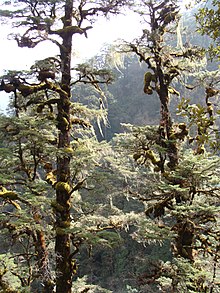Tsuga dumosa
| Himalayan hemlock | |
|---|---|
 |
|
| Scientific classification | |
| Kingdom: | Plantae |
| Division: | Pinophyta |
| Class: | Pinopsida |
| Order: | Pinales |
| Family: | Pinaceae |
| Genus: | Tsuga |
| Species: | T. dumosa |
| Binomial name | |
|
Tsuga dumosa (D. Don) Eichler |
|
Tsuga dumosa, commonly called the Himalayan hemlock or in Chinese, Yunnan tieshan (simplified Chinese: 云南铁杉; traditional Chinese: 雲南鐵杉; pinyin: Yúnnán tiěshān), is a species of conifer native to the eastern Himalayas. It occurs in parts of Nepal, India,(Bhutan), Burma, Vietnam, Tibet, and China. Within its native range the tree is used for construction as well as for furniture. In Europe and North America, it is occasionally encountered as an ornamental species and was first brought to the United Kingdom in 1838.
Tsuga dumosa is a tree growing 20 to 25 metres (65 to 80 ft) high and exceptionally to 40 m (130 ft). The diameter at breast height is typically 40 to 50 cm (16 to 20 in), but can be beyond 100 cm (40 in). The crown on small trees is ovoid and their form is like that of pendulous bushes. Older trees tend to have multiple stems from one or two sinuous boles, especially in cultivation. The crown of mature trees is broad, irregular-pyramidal and open. The bark is a similar to that of an old larch: somewhat pinkish to grey-brown and heavily ridged with broad, shallow, flaky fissures. The branches are oblique or horizontal. The twigs are reddish brown or greyish yellow in their first year and are pubescent, i.e. covered with short hairs. Branches that are 2 to 3 years old are greyish brown or dark grey with leaf scars. The wood from the tree is a brownish yellow with a fine structure and straight veins.
...
Wikipedia

